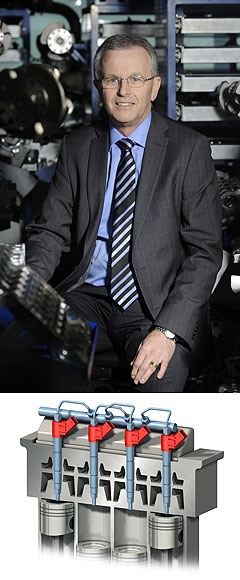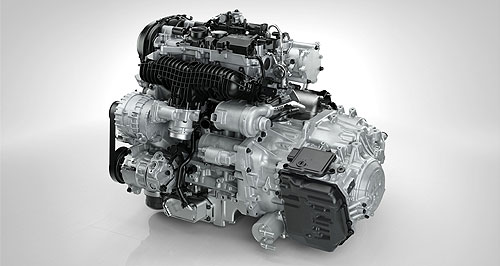News - VolvoVolvo’s next-gen engines smaller, more powerfulNew power: Volvo’s Drive-E range of engines will be available in the updated XC60 SUV in Europe in the coming months. Drive-E engines to be smaller but more powerful than Volvo’s current powertrains19 Aug 2013 VOLVO will offer twin-turbocharged and supercharged power when it introduces its new-generation “Drive-E” line-up of smaller, but more powerful engines later this year. Previously known as Volvo Engine Architecture (VEA), the Drive-E range of engines consists of two base four-cylinder units – a common-rail diesel and a direct-injection petrol engine – that will replace the existing eight-engine line-up over three platforms. The first examples of these engines will power the heavily revised S60 and V60 mid-size sedan and wagon range, as well as the XC60 SUV due out in Europe this quarter. While the updated model range is expected to arrive in Australia in the fourth quarter of this year, it is not yet clear which models will carry the new engine technology in the local line-up. Volvo Car Group vice-president of powertrain engineering, Derek Crabb, said the new engines and addition of plug-in hybrid technology would ensure more power, but better efficiency than the current crop of engines. “We have created smaller, more intelligent engines with power curves that give exciting driveability compared with engines with more cylinders, yet deliver the fuel economy of only four cylinders,” he said. In a statement, Volvo said the Drive-E diesel engines had a power range between 90kW and 170kW, while the petrol units produced between 104kW and 228kW. Volvo said there were a number of levels of turbo-charging depending on the vehicle, ranging from fuel-efficient variants to more powerful models. Three new powerplants from the engine family, including a 228kW turbo petrol T6, a 182kW T5 and 135kW turbo-diesel D4 will be available in the updated S60, V60 and XC60. The T5 and D4 diesel units will be available in the updated V70, XC70 and S80 line-ups in Europe. Volvo’s new generation of engines, which were designed in-house and built at Volvo’s Skovde, Sweden plant, are matched to a newly developed eight-speed automatic transmission or an updated six-speed manual gearbox.  Left: Volvo Car Group vice-president of powertrain engineering, Derek Crabb. Left: Volvo Car Group vice-president of powertrain engineering, Derek Crabb.Mr Crabb said Drive-E engines and the new transmissions were tuned for better fuel efficiency, lower emissions and more power than the outgoing powerplants. “Our four-cylinder engines will offer higher performance than today’s six-cylinder units and lower fuel consumption than the current four-cylinder generation,” he said. “If you take a four-cylinder Drive-E engine versus any six-cylinder engine, there’s a massive weight and size reduction for the same power. Fuel economy savings are anything from 10 to 30 percent, depending on which engine you’re comparing it to.” The Drive-E diesel powertrain employs Volvo’s ‘i-Art’ technology which uses a small computer on top of each injector to monitor injection pressure. The i-Art system then ensures the appropriate amount of fuel is injected during each combustion cycle. Diesel variants also benefit from twin-turbo induction as well as a smart valve solution for the cooling system that allows for a faster heat-up after a cold start. Volvo said it would use a supercharger to fill in the bottom end torque of the petrol engine to give it a naturally-aspirated feel. Further improvements to the Drive-E petrol engines include friction-reducing measures such as ball bearings on the camshaft, continuous variable valve timing and heat management with a variable electric water pump. Volvo confirmed the range of new powertrains were ready for electrification, with the compact size of the four-cylinder engines allowing for easy fitment of the electric motor in the front or rear of the vehicle, while the battery pack could be located in the centre of the car. The Swedish car-maker announced in late 2011 it would roll out a new engine line-up across its range, for all vehicles from its smallest cars all the way up to its flagship XC90 luxury SUV. Earlier this year, Mr Crabb said the new technology combined with the potential for electrification would see V8 engines go the way of the dinosaur. “We will create smaller, more intelligent engines with so much power that they will turn V8s into dinosaurs. Our four-cylinder engines will offer higher performance than today's six-cylinder units and lower fuel consumption than the current four-cylinder generation. “On top of that, electrification will bring us up into power figures in today's V8 territory,” he said. As previously reported, most of Volvo’s passenger line-up, with the exception of the recently launched V40 hatch and aging XC90 SUV, is set to receive a major overhaul later this year. The S60 and V60 mid-size range, XC60 SUV, XC70 crossover, S80 sedan and V70 wagon feature revised front-end styling, interior tweaks and safety upgrades, and are expected to arrive in Australian showrooms in the last quarter of this year.  Read more29th of April 2013  Volvo adds spin to fuel savingsA lightweight flywheel can make big cuts to fuel bills, says Volvo22nd of April 2013  Volvo S60 Polestar to boost image, salesVolvo looks to new flagship to bolster sedan range, boost broader S60 sales20th of February 2013  Volvo updates on the way‘Most extensive’ model renewal in Volvo history to hit Australia by end of 2013 |
Click to shareVolvo articlesResearch Volvo Motor industry news |
















Facebook Twitter Instagram